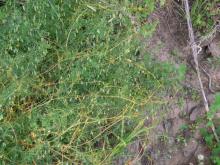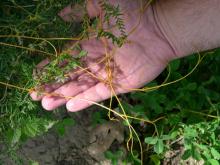Cause Annual, parasitic seed plant belonging to the genus Cuscuta, which lives on alfalfa and other plants including commercial crops and weeds. Dodder plants have rootless, leafless stems that encircle and penetrate alfalfa stems, diverting host nutrients. Dodder is favored by high temperatures and full sunlight. Dodder seed can remain viable in the soil for 20 years. Dodder seeds are gray to brown, irregularly round with a rough surface texture, and are similar to clover and alfalfa seed in density.
Symptoms A tangle of leafless, thread-like stems that are yellow, orange, purple, or white entwine alfalfa stems. Tiny white, pink, or yellowish flowers in clusters appear in June; seeds are produced from midsummer until frost kills the plant.
Cultural control See also the PNW Weed Management Handbook for additional information.
- Plant alfalfa seed free of dodder seed.
- Do not use alfalfa hay with dodder in it.
- Do not graze dodder areas and then put animals on clean land.
- Avoid spreading dodder seed in irrigation water.
- Cut dodder-infected plants before the dodder develops seeds.



